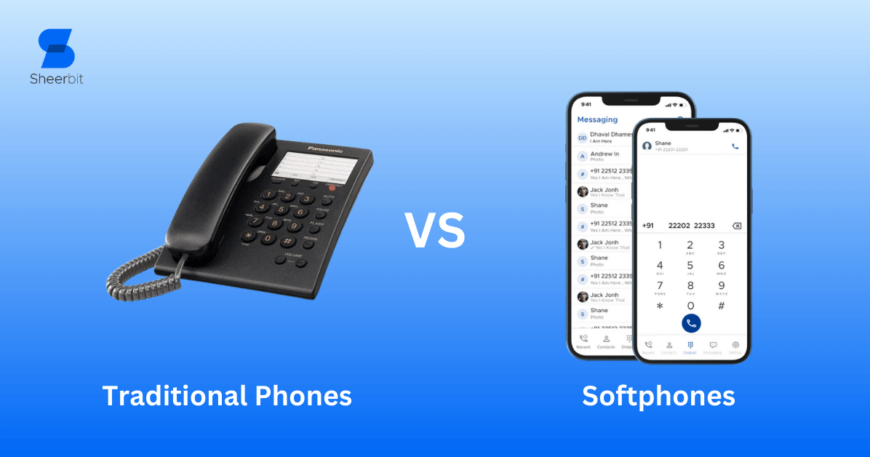We will delve into the comparison between softphones and traditional phones to determine which reigns supreme in modern communication. We will provide an overview of softphones and traditional phones, explaining their functionalities and purposes. By the end of this post, you’ll have a clearer understanding of the pros and cons of each option.
Understanding Softphones and Traditional Phones
Softphones are software-based applications that allow users to make phone calls over the internet using their computers or mobile devices.
Traditional phones, on the other hand, refer to physical hardware devices. They are connected to a telephone network for making and receiving calls.
We will highlight the key features and functionalities of softphones, such as call forwarding, video conferencing, and integration with other communication tools. Similarly, we will explain the basic functions of traditional phones, including dialing, receiving calls, and voicemail.
By exploring the advantages and disadvantages of softphones and traditional phones, we will give you a comprehensive understanding of their strengths and limitations.
Cost Comparison and Affordability
This section will focus on the cost implications of using softphones and traditional phones. We will discuss factors such as initial setup costs, ongoing expenses, and maintenance fees associated with both options.
We will emphasize the potential cost savings that can be achieved with softphones. For example, using softphones eliminates the need for physical phone lines and equipment, resulting in reduced expenses.
Affordability of Traditional Phones: On the other hand, we will address the affordability of traditional phones, considering factors such as hardware purchase, installation, and maintenance costs.
Mobility and Flexibility
Here, we will explore the mobility and flexibility advantages offered by softphones. Softphones allow users to make and receive calls from anywhere with an internet connection, enabling remote work, traveling, and on-the-go communication.
In contrast, we will discuss the limitations of traditional phones regarding mobility. Since they are physically connected to telephone lines, they lack the flexibility to be used outside a specific location.
Comparative Analysis: By providing a comparative analysis, we will help you determine which option, softphones or traditional phones, better suits your mobility needs.
Call Quality and Reliability
We will delve into the call quality aspects of softphones, emphasizing advancements in technology that have significantly improved audio and video clarity. Factors such as codec selection and internet connection stability will be discussed to highlight the reliability of softphone calls.
In this section, we will evaluate the call quality of traditional phones, considering factors like signal strength and line quality. We will address potential issues such as call drops, static noise, and limited audio capabilities.
Comparing Reliability: By comparing the call quality and reliability of softphones and traditional phones, we will provide insights into which option offers a superior communication experience.
User Experience and Interface
Here, we will focus on the user experience and interface of softphones. We will highlight their intuitive interfaces, customizable features, and user-friendly design. Additionally, we will discuss how softphones offer seamless integration with existing communication tools and workflows.
In contrast, we will discuss the user experience and interface of traditional phones, which often involve physical buttons and limited customization options. We will explore any potential complexities or challenges associated with their usage.
Comparative Analysis: By conducting a comparative analysis of the user experience and interface, we will help you understand which option, softphones or traditional phones, provides a more user-friendly and efficient communication experience.
Integration and Compatibility
This section will focus on the integration capabilities of softphones. We will discuss how softphones can easily integrate with other communication tools such as email, CRM systems, and team collaboration platforms. Furthermore, we will highlight their compatibility with various operating systems and devices.
We will address the compatibility of traditional phones with different telephony systems and explore any limitations they may have in terms of integration with modern communication technologies.
Comparative Analysis: By conducting a comparative analysis of the integration and compatibility features, we will provide insights into which option, softphones or traditional phones, offers better interoperability with other tools and systems.
Security and Privacy
This section will delve into the security measures implemented in softphones, including encryption protocols, secure authentication methods, and protection against potential vulnerabilities. We will address common security concerns and provide information on how softphones ensure privacy and data protection.
We will explore the security aspects of traditional phones, discussing the physical nature of their communication and the potential risks associated with wiretapping or eavesdropping.
By conducting a comparative analysis of the security and privacy features, we will help you understand which option, softphones or traditional phones, offers better protection of sensitive information.
Use Cases and Industry Applications
In this section, we will explore various use cases of softphones across different industries. For example, we will discuss how softphones enable flexible communication for remote teams. Improve customer support interactions, and enhance collaboration among distributed workforces.
Similarly, we will highlight the specific use cases of traditional phones, such as their prevalence in traditional office settings and industries where physical hardware is still preferred.
By conducting a comparative analysis of the use cases and industry applications, we will provide insights into which option. Softphones or traditional phones is better suited for specific business needs and communication requirements.
Conclusion and Recommendation
Based on the presented information, we will offer a balanced conclusion on which option, softphones or traditional phones, may reign supreme. We will emphasize the importance of considering individual needs, preferences, and specific use cases when making a decision.
In the final part of this post, we will provide personalized recommendations based on different scenarios. Helping readers choose the communication solution that best aligns with their requirements.





